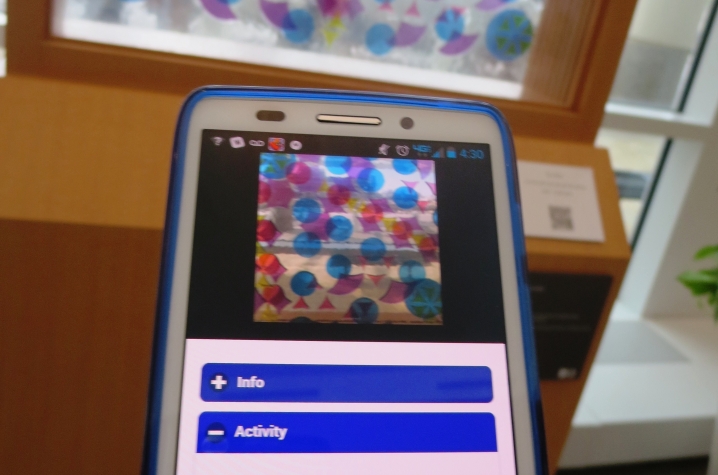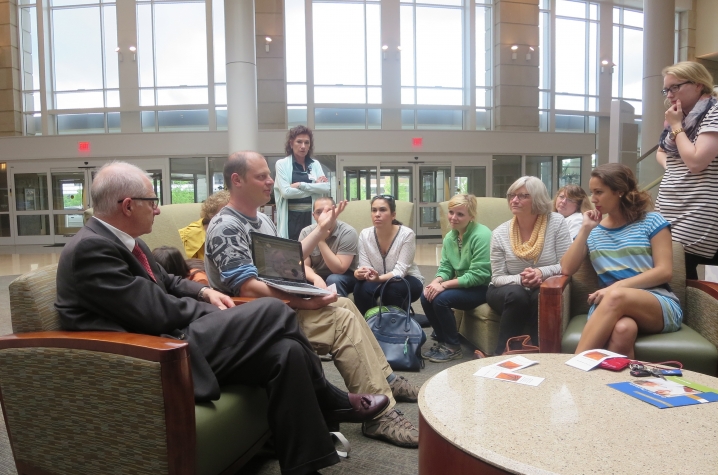Student-Developed QR Codes Engage Viewers of UK Arts in HealthCare Collections
LEXINGTON, Ky. (May 8, 2014) ― The vibrant colors and variety of wildlife portrayed in Robert Tharsing's vibrant "A Natural History of Kentucky" draws a casual interest from visitors in a waiting room on the first floor of the University of Kentucky Albert B. Chandler Hospital.
With a new QR code providing background information and a simple activity, curious visitors can go a step further in their exploration of the painting with a smartphone. The artwork's assigned QR code, which is available on a new brochure developed by two classes in the School of Art and Visual Studies in University of Kentucky College of Fine Arts, engages visitors with an eye-spy game of Kentucky animals in the piece and thought-provoking questions concerning the artwork's theme.
To see what information (note image may be stretched when accessed via computer) the QR code will access for the Tharsing work, visit: http://bit.ly/1o4qpri.
Earlier in the spring semester, Jackie Hamilton, director of UK's Arts in HealthCare Program, took 12 students in Marty Henton's museum education course on a private tour of the art collection in the hospital. Students then chose a work, as well as its respective artist, to research and study. They developed a short description of the work and created a mobile activity to prompt observers to think a little more about the piece.
The students also designed a brochure that includes QR codes for each of their selected pieces and a map of the galleries, which can be found at the information desks in Pavilion A of the hospital. With the brochure, visitors can scan a QR code assigned to a specific piece and access a photo of the artwork, a description and a creative activity.
Hamilton said if the analytic reports show that hospital visitors are accessing the codes, she will consider including codes for more pieces in the Arts in HealthCare collection. She applauds the students' creativity designing activities to encourage more observer involvement in the artwork.
"The QR codes will provide immediate access to information about the artist and the work," Hamilton said. "More importantly, the students have developed activities around the piece so the observer is pushed into a deeper level of engagement."
Arts administration senior Samantha-Jane Harris, of Nicholasville, Ky., accompanied her mother Cibina Harris, a registered nurse in the department of infection control at UK HealthCare, on a trial tour of the collection using the QR codes brochure.
When the new pavilion of the hospital opened a few years ago, Cibina Harris brought her daughter to view the art. She said the artwork, in addition to the ability to learn more about it through a QR code, adds to the quality of the patient's experience.
"It gives another topic of conversation to get their mind off of what they're really here for," Cibina Harris said.
Through the project, Samantha-Jane Harris memorized fascinating details about the artwork and the artist of the piece she selected in the hospital. She thinks the course work developing QR codes for public artwork has helped prepare her for a career in the arts.
"It's along the lines of what I want to do - bridge the gap between the arts and health care," Samantha-Jane Harris said. "It's learning to engage people in art."
The brainchild of Henton, senior lecturer of art education, and Dima Strakovksy, associate professor of art intermedia, the QR code project came about as Henton looked for ways to show her museum education students how to use modern technology to stimulate the public's interest in art.
Henton approached Strakovsky for advice on the technical aspects of the project and was excited when her colleague suggested the project would also work well for his course on coding.
Henton's class of art history, arts administration and music students went to work on researching details on artwork featured at the hospital as well as information on the artists themselves. While preparing biographies for their favorite piece, they also crafted activities for viewers at a variety of ages. To see examples of the information and activities accessed via the QR codes, visit http://bit.ly/PSHRTk for Marjorie Guyon's "Still 2" and http://bit.ly/1krcKYM for LaVon Williams' "Out of the Wailing Artist."
The class even came up with ideas for video and interactive gaming that was too ambitious for the short timeframe, but could be added in the future.
Additionally, the QR codes are connected to Google analytics which will provide the students, faculty and hospital with important data -- from hometowns of viewers to popularity of a particular piece.
Arts administration senior and artist Caitlin Serey, of Ashland, Ky., was excited to participate in the project and sees the importance of combining more traditional education tools with advances in technology. "I believe it is very valuable because today we learn news about the community or arts through technological databases."
Strakovsky's coding students also enjoyed working on the QR project. "The project was interesting. Most of the classes you take at UK can only simulate the experience of working with another group to achieve a joint goal. Our issues and obstacles weren’t artificial or unrealistic, they were real," said Andrew Johnson, an art studio senior from Lexington.
Serey and Johnson also enjoyed the change in art venue from a more typical museum or gallery to a hospital, where the art and corresponding QR codes make the visit not only more hospitable but also recognizes people's needs in digesting information.
"Users can translate the text more easily when it is digital. Users with visual disabilities can also change the color and size of the text if it is on a mobile display to make it more easily readable, which obviously isn’t possible with a traditional physical sign," Johnson said.
In the end, students in both Henton and Strakovsky's classes found the project rewarding and hope that it will benefit patients, visitors and staff at the hospital for years.
"I would say it's a prototype of bigger and better things to come from our classes in the future," Henton said.
MEDIA CONTACT: Whitney Hale, whitney.hale@uky.edu; and Elizabeth Adams, elizabethadams@uky.edu










